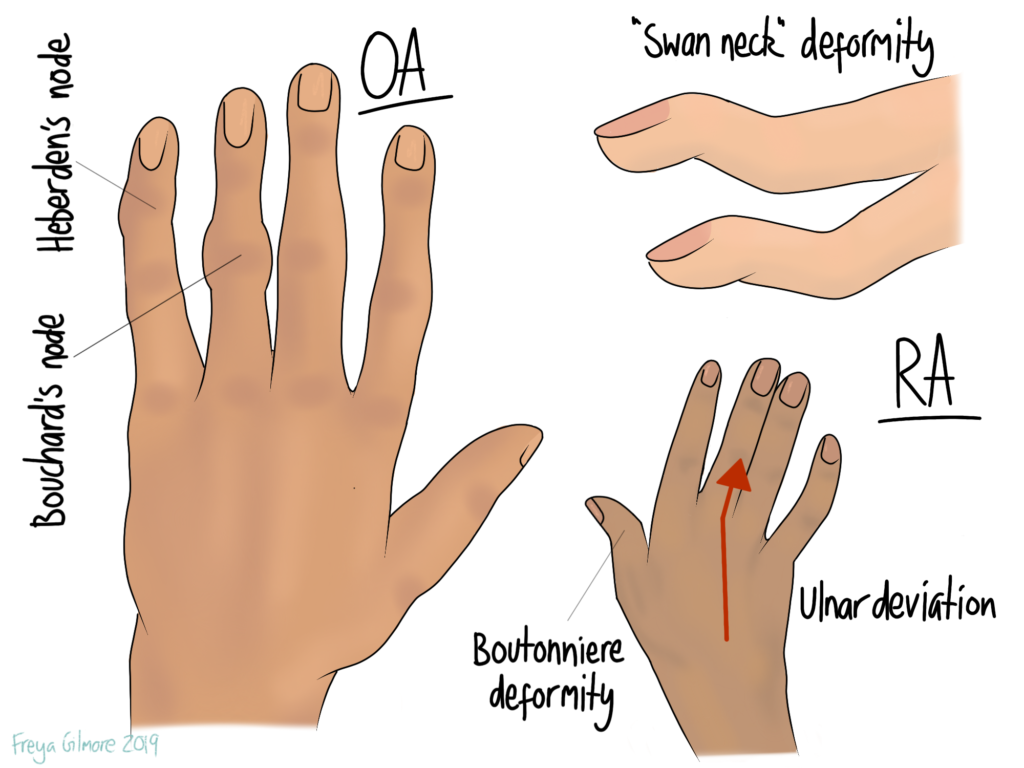Arthritic pain is a common problem that affects hundreds of millions of people worldwide. It causes significant discomfort and reduced quality of life. “Arthritis” is a group of conditions that involve inflammation of the joints, leading to pain, stiffness, and swelling. Among these conditions, osteoarthritis and rheumatoid arthritis are the most common, but other forms like psoriatic arthritis and ankylosing spondylitis are also worth knowing about.

Osteoarthritic Pain
Osteoarthritis (OA) is the most common form of arthritis, often referred to (pessimistically) as a “wear and tear” condition. It typically affects weight-bearing joints such as the knees, hips, and spine, but can also occur in the hands. In OA, the cartilage that cushions the joints degrades over time, leading to pain, stiffness, and reduced mobility. The pain associated with osteoarthritis usually comes on gradually and progresses over time. People with OA often experience increased pain with activity and relief during rest. Symptoms include joint stiffness, (particularly in the morning or after periods of inactivity), swelling, and a grating sensation when moving the joint.
However, as OA is a condition of living tissue (cartilage), there are things that can be done before the disease progresses too far. Cartilage wants movement to help bring it nutrients and remove its waste. If your osteopath can release the muscles that limit joint movement, and encourage mobility to return, we stand a good chance of making a positive impact on your symptoms.
Rheumatoid Arthritis Pain
Rheumatoid arthritis (RA) is an autoimmune disorder. This means the immune system mistakenly attacks the joint lining, causing inflammation and pain. Unlike osteoarthritis, which is primarily a degenerative disease, RA is characterised by its systemic nature, often affecting multiple joints symmetrically. RA typically presents with persistent joint pain, swelling, and stiffness, particularly in the hands, wrists, and feet. Small joints are typically affected first, with neck and hand pain often giving the first symptoms. Morning stiffness, lasting longer than an hour, is a key symptom of RA. Over time, the inflammation can cause joint damage and deformities (as illustrated above), significantly impacting daily activities and quality of life.
Other Forms of Arthritic Pain
Psoriatic arthritis (PsA) is a form of arthritis associated with psoriasis, a skin condition characterised by red, scaly patches. PsA can affect any joint in the body and often causes pain, stiffness, and swelling. This type of arthritis can also lead to changes in the nails and the appearance of “sausage-like” fingers or toes. Psoriatic arthritis can vary significantly from mild to severe, and its symptoms may fluctuate over time. Periods of remission are a hallmark of the condition.
Ankylosing spondylitis (AS) is a type of arthritis that primarily affects the spine, leading to chronic pain and stiffness. It can also affect other joints and tissues, including the hips, shoulders, and even the eyes. Over time, AS can cause the vertebrae to fuse, resulting in a loss of spinal flexibility and a hunched posture. Symptoms often begin in early adulthood and may include pain and stiffness in the lower back and hips, particularly after rest.
Osteopathy for Arthritic Pain
Osteopathy can play a significant role in managing arthritic pain. Osteopaths use a range of techniques to improve joint function and mobility, and reduce pain. Soft tissue stretching and massage are techniques used by osteopaths to alleviate muscle tension and improve circulation around the affected joints. This can help reduce inflammation and pain, providing relief for individuals with arthritis.
Joint mobilisation is another technique that involves gentle movements of the joints to increase their range of motion and flexibility. By reducing joint restrictions, osteopaths aim to improve joint function and allow for better access to nutrients while facilitating waste removal from the joint area. This can be particularly beneficial for individuals with osteoarthritis, where improved joint nutrition can help maintain cartilage health and slow down degeneration.
In addition to hands-on techniques, osteopaths can provide advice on exercises and lifestyle changes. We can prescribe stretching and strengthening exercises to improve joint stability and reduce the load on affected areas. We can also offer personalised ergonomic advice to further improve your mobility, and start to reduce your arthritic pain.
Click here to book an appointment for your arthritic pain with Beverley
